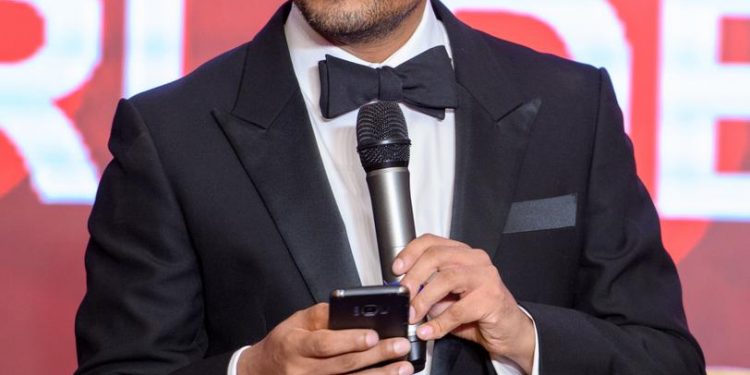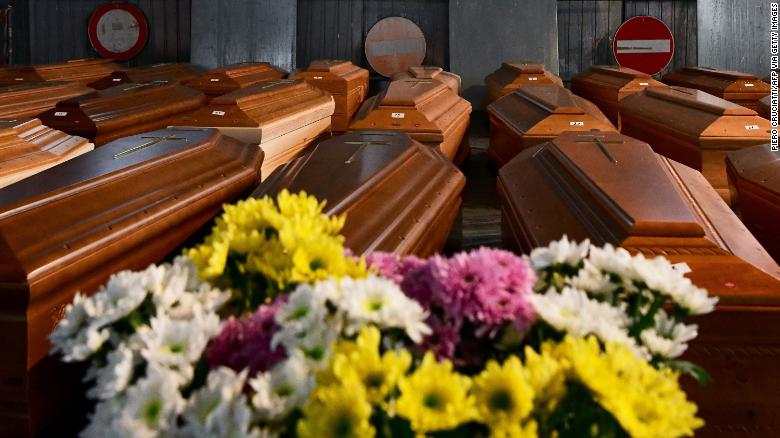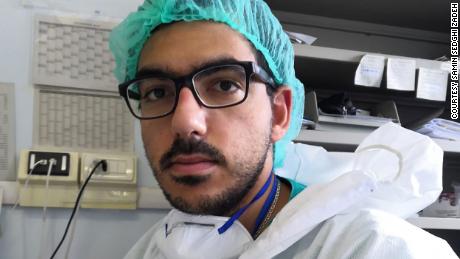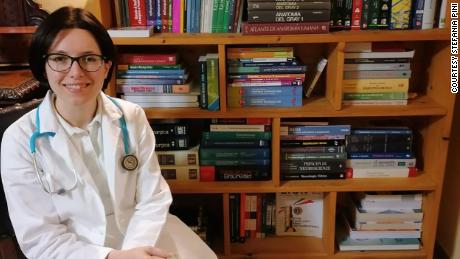Local residents queue to fill buckets and containers with water at a communal tap in Empompini in Cowdray Park, Bulawayo, Zimbabwe, on Saturday, Aug. 3, 2019. (Photo: Cynthia R Matonhodze/Bloomberg/Getty Images) Less
We have a mealie-meal crisis in Zimbabwe.
There has been a shortage of the staple food and thus the price of mealie-meal shot up from $40 to anywhere between $150 and $200 by December 2019. Whenever a shop receives a delivery of mealie-meal, a queue immediately forms and people jostle to buy. In these queues, there is absolutely no respect for personal space as people touch, rub against, lean on, push and shove each other for hours.
We have a transport crisis in Zimbabwe.
The majority of Zimbabweans use public transport and most use ZUPCO buses, which charge a fraction of what minibus taxis charge. For these bus rides, people queue for hours and they carry more than 50 passengers per trip.
The other option for public transport users is tiny cars (second-hand Honda Fits imported from Japan), that operate as pirate taxis and ferry at least six passengers per trip instead of the 3-4 passengers they were designed for. Daring operators add two more passengers in the car boot to increase their load per trip to eight or nine passengers. In these little taxis, people sit on each other, cough on each other, sneeze into each other’s faces, touch each other and sweat on each other.
We have a water crisis in Zimbabwe.
The majority of Zimbabweans in both rural and urban areas have no access to running water. We fetch water from rivers, boreholes and wherever else we can. In cities, people can go for days without water. The excuses by the government for failure to provide adequate water and sanitation services vary from shortage of chemicals, to lack of damning infrastructure, to drought. Lack of access to clean water cost thousands of Zimbabweans their lives during the cholera outbreak of 2018.
We have an unemployment crisis in Zimbabwe.
Independent statisticians have put it at above 90%. Many Zimbabweans have resorted to vending and various forms of self-employment in the informal sector. We have markets that house in the same vicinity: hardware hubs, carpentry workshops, car washes and vegetable markets … our towns and cities seem to have long abandoned town planning as wherever you go, there is someone selling something on the pavements, in street corners and in flea markets.
These areas are overcrowded and have no “real” infrastructure, so many have no toilets and no running water. Food, clothes, car parts and whatever you can think of, are sold wherever, whenever by whoever.
We have a Covid-19 crisis looming in Zimbabwe.
At a personal level, Zimbabweans cannot do much to prevent contracting or spreading Covid-19. There is no chance that people will social distance while jostling for mealie-meal or in overcrowded buses. There is no chance that we can correctly, constantly and consistently wash our hands under running water. There is no chance, unless literally at gunpoint, that Zimbabweans living from hand to mouth, will stay at home.
What will we eat?
At a national level, the situation is just as hopeless.
We have a production crisis in Zimbabwe.
As a country, we produce very little. Most of our groceries and clothes are imported. The closing of borders to Malayitshas and cross border traders will plunge the country into a serious shortage of basic commodities, from toiletries to food.
A lockdown will also be difficult to enforce as very few Zimbabweans have the capacity to buy food supplies for 21 days. Unless households are given food, it will be impractical to have a lockdown. People have to be able to leave the house every morning to hustle for money to buy food. Whatever most vendors make per day is for that night’s and the next day’s meals.
The Zimbabwean government knows and fears this, hence their failure to close our borders, as evidenced by the people that were still going in and out of the country even after announcement on 23 March 2020 that Zimbabwean borders have been closed; and to lockdown the country as South Africa has done. They also know that it would be political suicide to force a population on the brink of starvation to stay at home.
We have a health crisis in Zimbabwe.
Zimbabwean doctors have been complaining about the incapacitation of hospitals for years now. In 2019, they went on strike for months explaining that because they were not earning decent salaries, they could not even afford to transport themselves to and from work, and to feed themselves and their families.
Central to their grievances, was the state of the hospitals and lack of equipment. The doctors explained that our hospitals are dilapidated and unequipped for the core business of treating patients. They said there were no surgical gloves in hospitals, no disinfectants, no drugs – nothing basically to help them do their jobs of treating the sick. They said they were frustrated and tired of going to work to preside over senseless, and preventable deaths due to hospitals’ incapacitation.
In response to their grievances, the government fired doctors en masse.
Using the Zimbabwe ‘health system’: Real life experiences
In January 2020r, I took my cousin to our local hospital and they refused to treat her because she did not have the $140 consultation fee. Her mother is a teacher and at the time earned $1,000, an amount that could only buy her a combination of 30 loaves of bread at $15 each ($450), 10kg of mealie-meal at $150 and 5kg of meat. There was no chance she would have $140 lying around for emergencies such as this one. We sourced the money and paid, only to be told there was no doctor available and she would have to return the next day, despite her case being an emergency.
The nurses, who had no idea what was wrong with her, even after consulting google and a textbook they had, told us it could be mumps and prescribed medication, but advised us that the hospital pharmacy was closed and we would have to find a private pharmacy. All this after paying an amount equivalent to 14% of her mother’s salary. They did not even have paracetamol.
This was how dire the situation was for hospitals, health personnel and patients prior to Covid-19 landing in Zimbabwe. Now that we are faced with the possibility of an outbreak, what chance does Zimbabwe have?
We have already heard that doctors and nurses have gone on strike until they are given adequate personal protective equipment (PPE) to deal with the virus. Wilkins Infectious Diseases hospital, Harare’s isolation centre was shut down, reportedly for renovations, on 27 March 2020. It is clear that our health sector is at present unable to handle the looming Covid-19 outbreak.
On 20 March 2020, I posted this thread on twitter :
#Sigh. So Gwanda hospital has people exhibiting #Covid_19 symptoms,
Spoke to some,
Who said they’ve been investigated & cleared,
I’m like wow!
So fast?
Turns out no tests done,
There are no test kits at the hospital,
Investigation was verbal
#ZanuPfMustGo
“They have no hand sanitizers at the wards,
They don’t even at the very least,
Have soaps for hand washing in the bathrooms.
They have face masks thou,
But that’s hardly enough.
There are kids with pneumonia,
Nurses says there’s a pneumonia “outbreak”.
#ZanuPfMustGo”
An hour after I posted the tweets about the suspicious cases, the Minister of Health was on national TV announcing Zimbabwe’s first (official) Covid-19 positive patient.
We have a propaganda crisis in Zimbabwe.
This has led to trust issues between the people and the state. We have no idea what part of the news reported by state media is factual and what part is misinformation? Up to that point, the government had been insisting that we had no positive cases yet in the country. A declaration many found to be suspicious considering the fact that by 20 March 2020, nearly 100 people had already tested positive in neighbouring South Africa.
Also, a Chinese woman exhibiting Covid-19 symptoms died on her way to Wilkins Hospital, but authorities insisted she had not died of Covid-19. A British tourist to the Victoria Falls, who had fallen ill while still in Zimbabwe, had tested positive once he got back to England. Namibia had also announced that someone who had tested positive in Namibia had come from Zimbabwe two days before. Add the fact that we were still letting people from all over the world come in and out of the country at will, and it was puzzling how we had got to be so lucky. Many thought the government of Zimbabwe was not being honest.
The next morning, Nelson Chamisa, leader of the opposition MDC, announced on his Twitter page that two more people had tested positive for the virus. Government was then forced to make a statement, but they claimed only one more person had tested positive and the other patient’s results were inconclusive.
It became apparent to many that the government was withholding information.
The death of Zororo Makamba
On 23 March 2020, we were shocked to hear of the death of Zororo Makamba, a 30-year-old pro-government journalist and son of James Makamba, a businessman and a former Zanu-PF member of parliament. He had succumbed to Covid-19. One wonders at what point the government discovered he was positive and why they had not informed the nation. Had Nelson Chamisa not spilled the beans, would they have told us?
How many more people have died or recovered from the virus that the government is hiding?
Zororo is said to have landed at the Robert Mugabe International airport from New York on 10 March. He is alleged to have recorded a high fever upon entry. Airport staff wanted to detain him, but Zororo allegedly called someone who apparently then instructed airport officials not to quarantine him and he was allowed to leave the airport, unleashing Covid-19 on an unsuspecting public.
He had several meetings over the next few days, including with someone from the office of the president and cabinet as well as someone from the ministry of finance. Speculation is high that he was chasing payment for his propaganda videos. He was also seen at Pablos nightclub, a high-end club in Borrowdale where the country’s rich kids (read Zanu-PF kids) party.
I posted this on Twitter after Zororo’s death:
Expects us to believe,
To accept,
That from the 10th of March when Zororo landed in Harare,
Going through customs,
On the drive home,
Reunions with loved ones,
Before he fell sick,
During his illness,
Until his death,
He didn’t infect anyone?
#ZanuPfMustGo”
Even after interacting with many people from the day he landed, the government is mum on who else was infected by Zororo, or at least suspected to have been infected. Since his death, three more people have tested positive, but the nation is yet to be given details on the new infections.
It is said Covid-19 is more infectious than the flu. In other countries, it is spreading like a wildfire. We have heard of South Korea’s “patient 31”, whose case explains just how infectious this virus is, but the government of Zimbabwe expects the nation to believe that Zororo, who was allowed to roam around freely despite exhibiting symptoms, did not infect other people.
Zororo’s brother told the nation that staff at Wilkins Hospital were afraid of being around Zororo. He alleges that they would leave him unattended for hours and Zororo would call home telling them he was not being attended to. They were helpless because they were not allowed into the hospital. He says the doctor in charge switched off his phone.
According to Zororo’s brother, Wilkins Hospital has no ventilators and even after they sourced one privately, the hospital failed to use it as there were no compatible electrical sockets in the hospital. The family apparently called the president to intervene, but even that could not save Zororo.
One wonders if one so monied and well connected could not get treatment, do ordinary Zimbabweans have a chance?
We have a corruption crisis in Zimbabwe.
The story of Zororo Makamba is a sad, but illuminating tale. It is appalling that we are led by people who, as a “favour” can allow someone exhibiting one of the most telling symptoms of Covid-19 to avoid quarantine. It illuminates the dangerous privilege, corruption, negligence, abuse of power, elite capture of institutions, failure and collapse of health institutions, the gap between the rich and the poor, and the absolute lack of readiness by Zimbabwe to deal with Covid-19 or any other crisis for that matter – much the same way the government failed to deal with Cyclone Idai, drought, cholera and typhoid before. It exposes the extent to which the government of the day is unsuitable to rule.
We have a leadership crisis in Zimbabwe.
Covid-19 is exposing the failure of Zimbabwe as a state and the disaster that is Emmerson Mnangagwa. The current leaders are insensitive and completely detached from the suffering of the masses. In a clear display of cluelessness, instead of coming up with a context specific message, the president copied and pasted the general “how to prevent coronavirus” message on his Twitter feed.
He advised us to practice social distancing. Does he know, or care about the mealie-meal shortage and transport situations?
He advised washing of hand. Does he know we have no water?
He says people must stay at home, but he then immediately got on a flight to Namibia.
How does he expect this to work when we survive on odd jobs and vending? The president must first address these pertinent issues and tailor a strategy to curb Covid-19 that takes those issues into consideration.
Wilkins Hospital reportedly asked the government for $6.7-million to get the hospital ready for Covid-19, but they were apparently only allocated a mere $100,000.
During that time, Mnangagwa flew to Namibia (for the presidential inauguration), on a hired private jet that flew from Dubai to Harare to take him on the hour-long trip to Namibia. How does one explain such gross extravagance at a time when the nation is facing an outbreak our hospitals cannot handle? Around that time, Mthuli Ncube, Mnangagwa’s Minister of Finance, was also gallivanting in Europe where pictures of him shaking people’s hands were taken. Was he quarantined upon return?
A day after the shipment of donations from Jack Ma landed in Zimbabwe, pictures of Mnangagwa holding a meeting of people wearing Zanu-PF regalia and face masks circulated on social media? Where did they get the masks? At a time when doctors and nurses have no personal protective equipment, they saw it fit to waste the scarce masks on themselves.
What a shame.
We have a marginalisation crisis in Zimbabwe.
Covid-19 is also exposing the extent to which the Zanu-PF government has been marginalising many parts of the country – most rural areas and all of Matebeleland since 1980. As it is, the government is in a panic and trying to refurbish Wilkins Hospital, and accused of getting an elitist Covid-19 centre ready for the ruling political elite.
What about the rest of the country?
The whole of Matebeleland province only has Thorngrove Hospital, a rundown infectious diseases hospital that has no capacity to handle any illness. So where is the rest of Zimbabwe going to go if the virus spreads? We cannot all go to Harare.
We have a political crisis in Zimbabwe.
Because the government is guilty of neglecting their mandate to provide public goods, they are going out of their way to hide information about the extent of infections in Zimbabwe. In their 40 years of power, Zimbabwe has failed to build hospitals and clinics, or to maintain the hospitals built by the Rhodesians. They let the health systems completely crumble and if Covid-19 hits Zimbabwe as badly as we fear, it will be entirely their fault. Millions of people are going to suffer and thousands risk dying unnecessarily because of the state of our health sector.
Because of all these crises, Zimbabwe is an unfolding disaster. The government, which has misgoverned the country for decades, has neither capacity nor desire to deliver on matters of national and public interest. They just do not care.
My only prayer is that geographical and environmental factors like our weather, the age of people concentrated in the cities and sheer luck will protect us. This is a terrible, frightening and also infuriating situation. We have no reason to be experiencing this uncertainty. Covid-19 may be a natural disaster, but if it spreads in Zimbabwe, its effects will be entirely man-made.
God save Zimbabwe. MC
Thandekile Moyo is a writer and human rights defender from Zimbabwe. For the past four years, she has been using print, digital and social media (Twitter: @mamoxn) to expose human rights abuses, bad governance and corruption. Moyo holds an Honours degree in Geography and Environmental Studies from the Midlands State University in Zimbabwe.











